police brutality

In a nation founded on violence, how are we to respond when young indigenous people are beaten to death by police or young black men are shot in the front seat of their cars? What do we do when young Muslim women are assaulted on the way to say prayers with their community? In an attempt to protect ourselves from violence, we actually bring violence to our schools and neighborhoods, because we live a gospel of violence perpetuated over time by our attitudes of hate and racism toward one another.
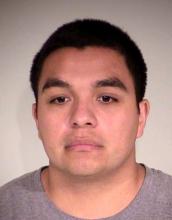
After five days of deliberation, a jury has found the police officer who fatally shot Philando Castile not guilty on all charges.
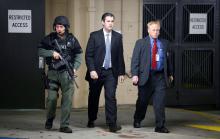
The civil rights case of Slager's involvement in Scott's death was slated to go to trial later this month. Slager faces several charges in the death of Walter Scott, including lying to fellow law enforcement officers about details of the incident. Moments following Walter Scott’s death were captured on video, and in the video Slager places an object besides Scott’s body — suspected to be his Taser, which would go against Slager’s account that Scott took Slager’s Taser.

But more deeply than that, framing Terence’s last gasp of life in the texture of local challenges shows the frailty of black Tulsa’s dream of equal treatment. We need to ensure Terence does not become another note on a scale of the pain felt by countless black and brown lives. It’s only been seven months and the voices of those affected by this history have been diminished.
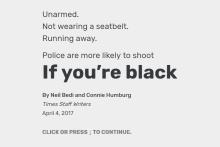
Black motorists in Florida are twice more likely to be shot by police after being pulled over for a traffic violation than white motorists in Florida, reports the Tampa Bay Times in an online interactive, “If You’re Black.”
This statistic is part of a new investigative study by the paper of every police shooting that occurred in Florida from 2009-2014. The newspaper gathered data from autopsies, news articles, police reports, and subsequent lawsuits.
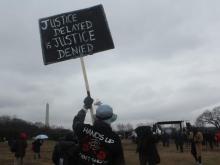
Crying out “no justice, no peace,” crowds joined the Rev. Al Sharpton in a weekend march towards the Martin Luther King Jr. Memorial, vowing not to let President-elect Donald Trump turn back strides made by the civil rights leader.
The mostly African-American throng — smaller than the thousands expected, due to the steady rain — heard from civic and religious leaders about key areas of concern: health care, voting rights, economic equality, and police brutality and reform.
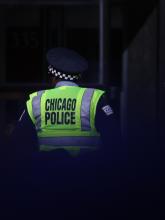
There were more than 400 force reports and over 170 officer related shootings in Chicago from January 2011 to April 2016 that. Not only did the department review, investigate and analyze these police documents, procedures, and trainings, they met with city leaders, community organizers, former police officer, rode along with current officers, and heard from over 1000 community members before making this judgement.
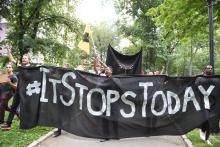
The Injustice Boycott has selected three locations that it plans to affect: New York City, San Francisco, and Standing Rock. The initiative will give the government leaders of those locations until Jan. 17, the day after Martin Luther King Jr. Day, to answer to the demands of local activists and organizers, and if those demands aren’t answered by that day, the Injustice Boycott will launch several actions against the city. These actions will include a tourism boycott of those cities; pulling money out of banks, financial institutions, and large corporations that either support racial injustice and police brutality in those cities or have not come out against them; and protests in the city that will be designed to shut down the work of businesses and city government.

Terrence M. Cunningham, the president of the International Association of Chiefs of Police, apologized Oct. 17 on behalf of police in the U.S., “for the actions of the past and the role that our profession has played in society’s historical mistreatment of communities of color,” reports the Washington Post.
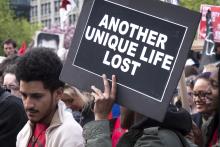
I don’t need to remind you, but I will, that this is the mentality of slave owners — the muscle memory of oppression that beats in American hearts still, in quiet and loud ways, and leads the systems of this nation to marginalize those who look different than the most privileged.
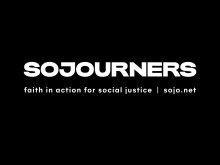
Every black parent in America has to have “the talk” with his or her sons and daughters — about how to act and not act in the presence of white police officers with guns. It’s a painful family ritual that is slowly being discovered by America’s white parents as more and more police killings of young African Americans occur and are nationally discussed.

IN DECEMBER 2014, the white police chief of Richmond, Calif., showed up at a local protest against police brutality. The ethnically diverse city is infamous for its violent Iron Triangle neighborhood, but Chief Chris Magnus didn’t arrive at the protest to bust heads, or even to merely “keep an eye on” the assembly. Instead, he held a sign. It read, quite simply, “Black Lives Matter.”
The reaction was quick and intense—even the Richmond Police Officers Association issued a statement claiming Magnus had broken state law by “politicking” in uniform.
“I can understand how it is hard for a lot of police officers, especially given what has gone on in some of the protests,” Magnus said, according to the San Francisco Chronicle. Nevertheless, he doesn’t regret holding the sign. “I’d do it again,” he said. “[T]he idea that black lives matter is something that I would think that we should all be able to agree upon.”
Like Richmond’s police officers denouncing Magnus, negative national reactions to the Black Lives Matter movement have come quickly and decisively, replete with slogans such as “All Lives Matter” and “Blue Lives Matter,” which refers to police officers.
Churches with “Black Lives Matter” signs have seen the word “black” defaced. Darren Wilson, the Ferguson police officer who shot and killed Michael Brown, received hundreds of thousands of dollars from online donors, as did George Zimmerman, the neighborhood-watch vigilante who killed Trayvon Martin.
In May, Louisiana took “Blue Lives Matter” to the next level when Gov. John Bel Edwards signed the “Blue Lives Matter” bill that added public safety workers to protected-class status for hate crimes legislation, thereby joining ethnic, religious, and sexual minorities. And in July, following the police shootings of Alton Sterling and Philando Castile and the sniper killing of five Dallas police officers, protesters in Baton Rouge were met with armored tanks, percussion weapons, and the threat of being charged with the “hate crime” of obstructing police in response to their nonviolent actions.
This is the politics of polarization. Discussions on race in the United States too often behave according to Newton’s third law of motion: “To every action there is always opposed an equal reaction.” It’s true within the church as well: While 82 percent of black Protestants believe that police killings are part of a pattern, 73 percent of white mainline Protestants say the opposite—to them, Michael Brown, Eric Garner, Tamir Rice, Sandra Bland, Freddie Gray, and the hundreds of other unarmed black Americans killed by police are “isolated incidents.”

Judge Barry G. Williams, the same judge presided over the acquittals of Officers Edward Nero and Caesar Goodson, cleared Rice of involuntary manslaugher, reckless endangerment, and misconduct in office.

African-Americans often express frustration at white Americans for overlooking their grief at the deaths of young black men shot and killed by police.
On a conference call last week, hours before Micah Xavier Johnson, a black man, opened fire and killed five white police officers, about 500 Christians, black and white, tried to bridge that racial divide.
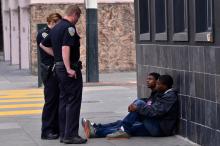
I didn’t know whether to stop. I turned the corner and noticed you first, before I noticed the police cars and the flashing lights and your car crammed full of stuff. You were standing there, jeans and hoodie. Hands in pocket and hood over your head. It was cold and you did not have on a coat. I was in my warm car, and you were standing in the January cold.
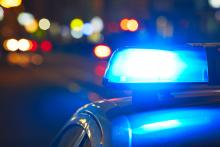
Let’s prosecute these police officers fair but hard because the shooting of innocent Black men and women is done in our names. Until there are consequences this will only continue.
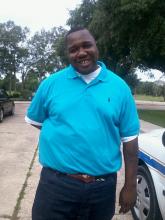
Police in Baton Rouge, La., shot and killed 37-year-old Alton Sterling after pinning him to the ground in a convenience store parking lot.
Graphic footage of the shooting has circulated online, sparking nationwide outrage and protests.
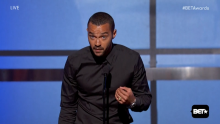
Best known for his role in "Grey's Anatomy," Williams stole the show on a night featuring a surprise performance by Beyoncé and Kendrick Lamar.
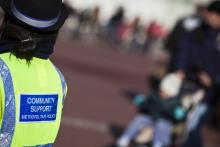
“We believe in the value, power, and potential of training to produce more effective, more capable, and better police officers,” the Ferguson Commission wrote. I believe in this, too. And I believe that investing in a better police force may yield a future where “liking the police” is no longer a privilege, but the norm.
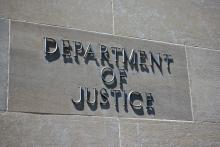
The Department of Justice will not pursue charges against the Minneapolis police officers who shot and killed Jamar Clark, U.S. Attorney Andrew Luger announced at a press conference June 1.